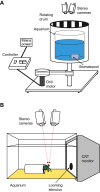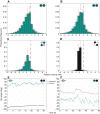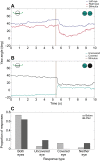The independence of eye movements in a stomatopod crustacean is task dependent
- PMID: 28356369
- PMCID: PMC5399772
- DOI: 10.1242/jeb.153692
The independence of eye movements in a stomatopod crustacean is task dependent
Abstract
Stomatopods have an extraordinary visual system, incorporating independent movement of their eyes in all three degrees of rotational freedom. In this work, we demonstrate that in the peacock mantis shrimp, Odontodactylus scyllarus, the level of ocular independence is task dependent. During gaze stabilization in the context of optokinesis, there is weak but significant correlation between the left and right eyes in the yaw degree of rotational freedom, but not in pitch and torsion. When one eye is completely occluded, the uncovered eye does not drive the covered eye during gaze stabilization. However, occluding one eye does significantly affect the uncovered eye, lowering its gaze stabilization performance. There is a lateral asymmetry, with the magnitude of the effect depending on the eye (left or right) combined with the direction of motion of the visual field. In contrast, during a startle saccade, the uncovered eye does drive a covered eye. Such disparate levels of independence between the two eyes suggest that responses to individual visual tasks are likely to follow different neural pathways.
Keywords: Gaze stabilization; Independent eyes; Mantis shrimp; Neural connections; Optokinesis; Saccade; Visual system.
© 2017. Published by The Company of Biologists Ltd.
Conflict of interest statement
The authors declare no competing or financial interests.
Figures






Similar articles
-
Complex gaze stabilization in mantis shrimp.Proc Biol Sci. 2018 May 16;285(1878):20180594. doi: 10.1098/rspb.2018.0594. Proc Biol Sci. 2018. PMID: 29720419 Free PMC article.
-
Gaze stabilization in mantis shrimp in response to angled stimuli.J Comp Physiol A Neuroethol Sens Neural Behav Physiol. 2019 Aug;205(4):515-527. doi: 10.1007/s00359-019-01341-5. Epub 2019 May 16. J Comp Physiol A Neuroethol Sens Neural Behav Physiol. 2019. PMID: 31093738 Free PMC article.
-
Shrimps that pay attention: saccadic eye movements in stomatopod crustaceans.Philos Trans R Soc Lond B Biol Sci. 2014 Jan 6;369(1636):20130042. doi: 10.1098/rstb.2013.0042. Print 2014. Philos Trans R Soc Lond B Biol Sci. 2014. PMID: 24395969 Free PMC article.
-
Stomatopod eye structure and function: a review.Arthropod Struct Dev. 2007 Dec;36(4):420-48. doi: 10.1016/j.asd.2007.01.006. Epub 2007 Mar 7. Arthropod Struct Dev. 2007. PMID: 18089120 Review.
-
Crustacean Larvae-Vision in the Plankton.Integr Comp Biol. 2017 Nov 1;57(5):1139-1150. doi: 10.1093/icb/icx007. Integr Comp Biol. 2017. PMID: 29155966 Review.
Cited by
-
Complex gaze stabilization in mantis shrimp.Proc Biol Sci. 2018 May 16;285(1878):20180594. doi: 10.1098/rspb.2018.0594. Proc Biol Sci. 2018. PMID: 29720419 Free PMC article.
-
Lessons from behavioral lateralization in olfaction.Brain Struct Funct. 2022 Mar;227(2):685-696. doi: 10.1007/s00429-021-02390-w. Epub 2021 Oct 1. Brain Struct Funct. 2022. PMID: 34596756 Free PMC article. Review.
-
A Biomimetic Model of Adaptive Contrast Vision Enhancement from Mantis Shrimp.Sensors (Basel). 2020 Aug 15;20(16):4588. doi: 10.3390/s20164588. Sensors (Basel). 2020. PMID: 32824224 Free PMC article.
-
Unidirectional Optomotor Responses and Eye Dominance in Two Species of Crabs.Front Physiol. 2019 May 16;10:586. doi: 10.3389/fphys.2019.00586. eCollection 2019. Front Physiol. 2019. PMID: 31156462 Free PMC article.
-
Gaze stabilization in mantis shrimp in response to angled stimuli.J Comp Physiol A Neuroethol Sens Neural Behav Physiol. 2019 Aug;205(4):515-527. doi: 10.1007/s00359-019-01341-5. Epub 2019 May 16. J Comp Physiol A Neuroethol Sens Neural Behav Physiol. 2019. PMID: 31093738 Free PMC article.
References
-
- Bradshaw J. L. and Nettleton N. C. (1981). The nature of hemispheric specialization in man. Behav. Brain Sci. 4, 51-91. 10.1017/S0140525X00007548 - DOI
-
- Byrne R. A., Kuba M. J. and Meisel D. V. (2004). Lateralized eye use in Octopus vulgaris shows antisymmetrical distribution. Anim. Behav. 68, 1107-1114. 10.1016/j.anbehav.2003.11.027 - DOI
-
- Cronin T. W. (1986). Optical design and evolutionary adaptation in crustacean compound eyes. J. Crustac. Biol. 6, 1-23. 10.2307/1547926 - DOI
Publication types
MeSH terms
Grants and funding
LinkOut - more resources
Full Text Sources
Other Literature Sources

